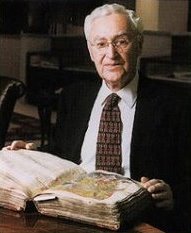This week’s post is a relatively short one. It’s a quick review of Bruce Metzger’s, The Canon of the New Testament: It’s Origin, Development, and Significance. Published in 1997 and reprinted in 2009 by Oxford University Press, this book is a good resource (288 pages plus four appendices) for those who wonder how the New Testament came to include the 27 books that we know today.
Bruce Metzger (1914-2007) was a New Testament scholar and textual critic, expert in Greek, and a longtime professor at Princeton Theological Seminary. Over the course of his life, he was a prolific writer, penning numerous books, translations of ancient works, and academic articles.
Critics of Christianity often make the argument that the New Testament’s contents were decided at the Synod of Carthage in 397 AD, where various church leaders assembled to consider a wide range of existing gospels, letters, and other documents, and then decide which ones would be included in the official canon. They assert that the Synod’s representatives simply rejected those documents with which they disagreed, or that were problematic for orthodox Christianity. As a result, the argument goes, many books and letters were hidden that, if widely known, would show core Christian beliefs to be false.
As we’ve written before, it is the argument stated above that’s false. The Canon of the New Testament provides deeper background as to why. It’s important to note that the book was not specifically written to counter critics. Rather, it simply presents an easily accessible and straightforward history of the canon’s development. That history sinks the critics’ argument by default.
Metzger starts by providing a summary of the research and literature published—up through the late 20th century—on the formation of the canon. This literature survey helps the reader grasp the various positions that researchers have taken over the decades.
He then takes the reader through a review of the Apostolic Fathers and their writings, paying special attention to the documents that they considered authoritative in their day. He covers such well-known names as Clement of Rome, Ignatius of Antioch, Papias, Polycarp, and others. Their writings provide a window into the documents that the very early churches were using in their services, and that they considered to be authoritative scripture. Metzger then moves through a discussion of key influences on canonical development, both positive and negative, including Gnosticism, Marcion, Montanism, the various persecutions of Christians, and more.
Metzger’s comparison of how the Canon developed in Eastern churches and Western churches is quite interesting, as is his review of the apocryphal books and writings that never made it into the canon. He concludes the book with a review of how the final canon came to be settled.
While digging into this book, the reader is struck by several realizations:
- The canon took a long time to reach its final form, evolving as churches, more or less independently, came into possession of various writings and began using them in their services.
- Over the years, churches looked most favorably on—and were more inclined to trust—writings that had a strong pedigree (i.e. that were written by Jesus’ original apostles or close family members, or direct followers of apostles) and that said things consistent with known authoritative works.
- Many works came along that claimed to have a strong pedigree, such as the Gospel of Thomas, the Gospel of Peter, and others. However, the churches eventually weeded them out, as they were able to determine that the authorship was not as advertised.
- Even though there was variability as to which writings various churches considered to be divinely inspired scripture, early churches were basically unanimous in accepting a number of writings that are core to the canon today. These writings include all four Gospels (Matthew, Mark, Luke, and John), Acts of the Apostles, and most of Paul’s letters. Basically, all early churches believed the pedigrees of these documents to be quite solid.
- There was a high degree of agreement among the churches regarding the works that were obviously of poor pedigree (or produced by known heretic groups who had no tie to the original apostles). While there were controversies, these were gradually settled as churches “figured it out” and questionable books fell into disuse.
- There was debate about a few books that ultimately did find a home in the Canon, such as Revelation, Hebrews, and the 1st and 2nd letters of John.
- By the time the modern canon was “decided” at the Synod of Carthage, the canon was largely already set due to this evolutionary process. The Synod merely made “official” a canon that had been already figured out by the churches.
In short, the books that made it into the New Testament canon we know today made it because they were of strong pedigree and were able to stand the tests of time and scrutiny. Those that didn’t make it were demonstrated to have no apostolic connection and/or said things that were contrary to known authoritative works. They weren’t suppressed. They fell out of usage—or never achieved usage—because they never demonstrated a trustworthy origin.

